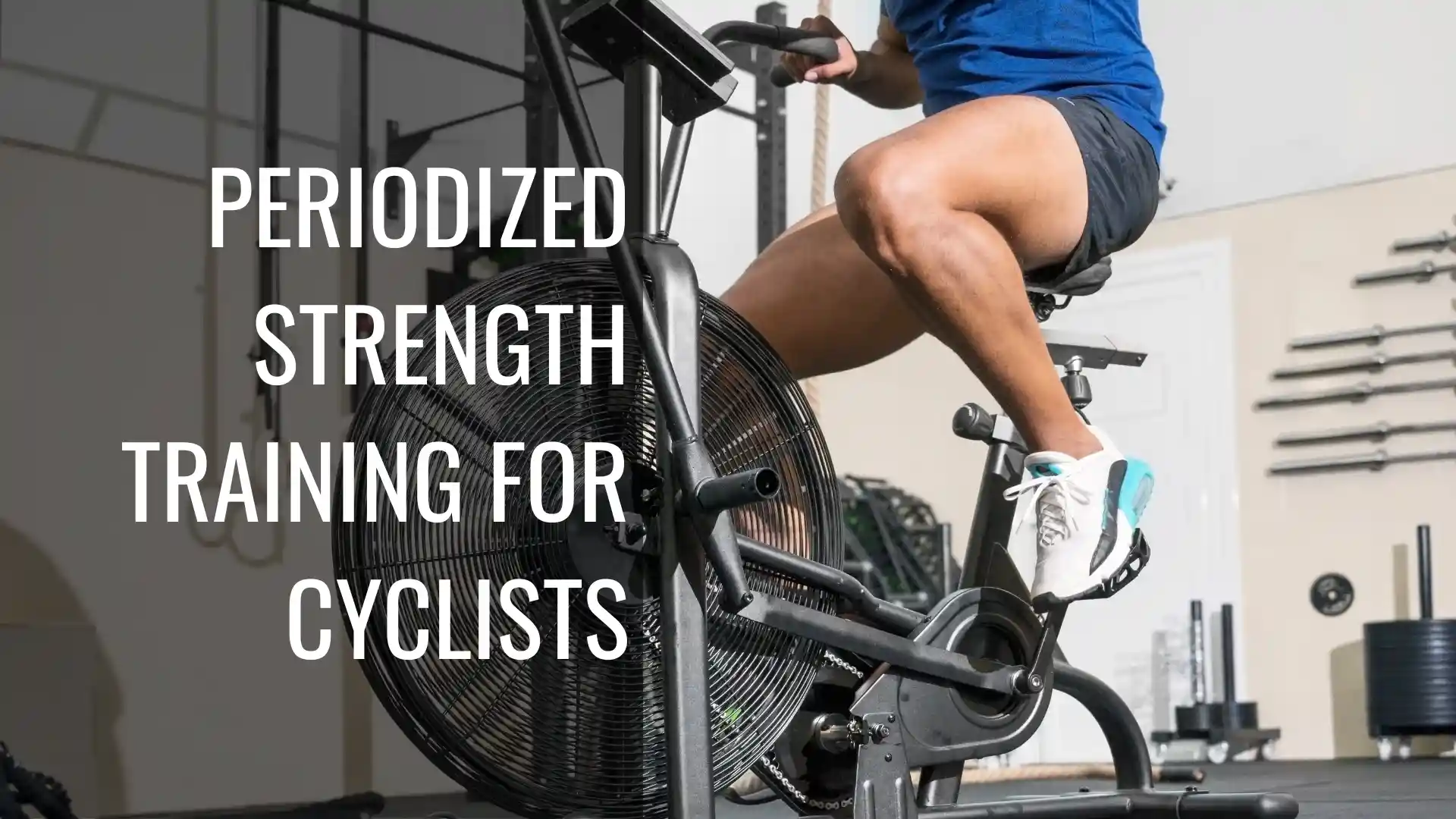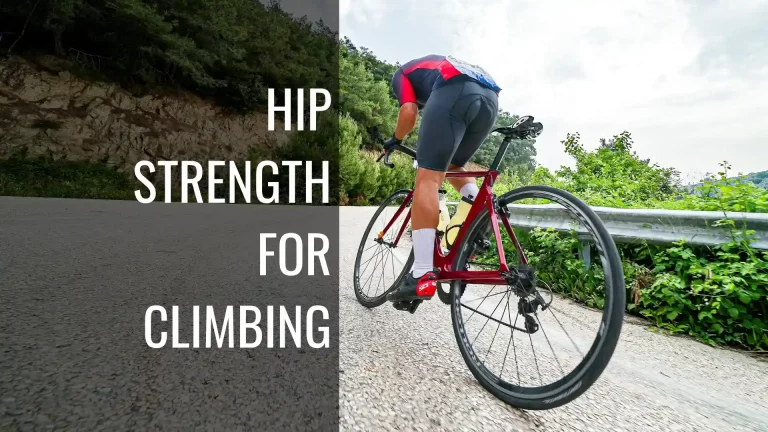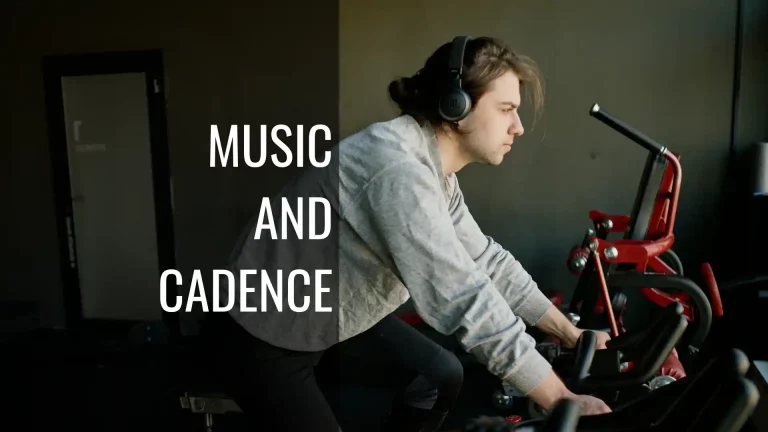
In this article, we’ll delve into the world of periodized strength training for cycling, exploring its benefits, key components, and how to create an effective program tailored to your goals.
PEDAL MY WAY NEWSLETTER
Weekly training tips, cycling strategies, and fitness insights for sustainable performance.
No spam—just actionable guidance to help you train smarter.
Table of Contents
Understanding Cycling Periodization Phases
The Main Periodization Phases
Build Phase (Preparation)
Peak Phase (Competition)
Recovery/Transition Phase
Training Variables
Throughout these phases, coaches manipulate several key variables: training volume (total hours), intensity distribution (time spent in different power/heart rate zones), training frequency, and specificity (how closely training matches race demands). The art of periodization lies in timing these changes to produce peak fitness when it matters most while maintaining long-term development and health.
This systematic approach helps cyclists avoid the common mistake of training too hard year-round, which often leads to plateaus, illness, or injury.
Off-Season Strength Training Focus Areas
- Core Strength: Developing strong core muscles improves stability, balance, and overall cycling efficiency. Incorporate exercises like planks, Russian twists, and bird dogs to target your abdominals, obliques, and lower back muscles.
- Lower Body Strength: Building strength in your legs and glutes helps to generate more power during the pedaling motion. Exercises like squats, lunges, deadlifts, and leg presses can improve the overall strength and endurance of your lower body.
- Upper Body Strength: While cycling is primarily a lower-body dominant sport, maintaining upper body strength is crucial for overall bike handling and control. Include exercises such as push-ups, pull-ups, and rows to strengthen your chest, back, shoulders, and arms.
- Plyometric Training: Plyometric exercises involve explosive movements that improve power and reaction time, which can be beneficial for sprinting and quick accelerations during cycling. Incorporate exercises such as box jumps, jumping lunges, and burpees to develop explosive power.
- Balance and Stability: Enhancing balance and stability can improve bike handling skills and reduce the risk of injury. Exercises such as single-leg squats, balance boards, and BOSU ball workouts can help develop these skills.
- Flexibility and Mobility: Maintaining flexibility and mobility is essential for preventing injuries and improving overall cycling performance. Incorporate stretching, foam rolling, and yoga to increase your range of motion and promote muscle recovery.
- Posterior Chain Development: Cycling tends to create imbalances by strengthening the front of the body while neglecting the back. Emphasize exercises that strengthen the glutes, hamstrings, and back muscles. Deadlifts and their variations, glute bridges, Romanian deadlifts, and rows should be staples. Strong glutes are especially crucial for power production and injury prevention.
Build Phase: Strength Maintenance Strategies
- Reduced Volume: The recovery phase isn’t about losing fitnes – it’s about becoming a more complete, balanced athlete who’s ready to tackle the next cycle of development with renewed energy and focus.Incorporate Resistance Bands: Use resistance bands to work on strengthening smaller muscle groups and stabilizers, which can help prevent injury and maintain overall strength during the build phase.
- Core and Stability Emphasis: As cycling volume increases, maintaining core strength becomes even more critical for handling fatigue during long rides and intervals. Focus on exercises that challenge stability while fatigued – planks after bike sessions, single-leg deadlifts, and anti-rotation exercises. These can often be done with minimal additional fatigue.
- Load Management Indicators: Monitor how strength sessions affect subsequent bike training. If your power numbers drop or you can’t complete prescribed intervals, reduce strength training further. The bike training takes priority during build phase – strength work should support, not hinder, cycling adaptations.
The key is finding the minimum effective dose of strength training that maintains your gains while allowing optimal adaptation to the increased cycling load. By maintaining strength throughout the build phase, cyclists can continue to develop and maintain muscular endurance, power, and overall cycling efficiency while reducing the risk of injury and over-training.
Race Season: Minimal Effective Dose Training
During the race season, athletes often need to balance their training workload with the demands of competition. One approach to maintain fitness while avoiding overtraining is using the Minimal Effective Dose (MED) training method. This strategy involves performing the smallest amount of training necessary to maintain or improve performance without compromising recovery and race readiness.
Here are some key aspects of MED training during the race season:
- Reduced Volume: Decrease your overall training volume to allow for proper recovery between races. This can involve shorter workouts and fewer sessions per week. One well-designed 20-30 minute session per week can maintain strength for 6-8 weeks during race season. Focus on 3-4 compound movements that target your biggest strength gains from the off-season. A typical session might include squats, deadlifts or Romanian deadlifts, a pulling movement, and core work. Use moderate loads (70-80% of your current max) with lower volume – 2-3 sets of 3-6 reps.
- High Intensity, Low Duration: Focus on high-intensity intervals and short, targeted workouts that maintain or improve power and speed without causing excessive fatigue.
- Prioritize Quality Over Quantity: Make each workout count by emphasizing proper form, technique, and focused effort to maximize the benefits of your training sessions.
- Monitor Performance and Fatigue: Keep a close eye on your performance metrics and how you feel during training and racing. Adjust your MED training as needed to ensure you’re recovering adequately and performing well.
- Incorporate Strength Maintenance: Continue with a reduced strength training program to maintain muscular strength and endurance, focusing on cycling-specific exercises. Bodyweight exercises can maintain strength adaptations. Single-leg squats, push-ups, planks, and glute bridges require no equipment and minimal time.
- Injury Prevention: Shift emphasis toward exercises that address the repetitive stress of racing and high-volume training. Hip flexor stretches, glute activation, and thoracic spine mobility become more important than pure strength development. These can often be incorporated into warm-ups or cool-downs without adding training time.
- Recovery Integration: Use strength training time for recovery-focused activities when race stress is high. Light stretching, foam rolling, or corrective exercises can provide more value than traditional strength work during intense race blocks. The goal shifts from building strength to maintaining function and preventing breakdown.
Recovery Phase: Active Restoration Methods
- Low-Intensity, Steady-State Cardio: Engage in low-intensity aerobic activities, such as walking, light jogging, or leisurely cycling, to promote blood flow, speed up recovery, and maintain a basic level of fitness.
- Stretching and Mobility Exercises: Improve flexibility and range of motion by regularly stretching your muscles and incorporating mobility exercises, such as dynamic stretching, foam rolling, and yoga.
- Light Strength Training: Perform low-intensity strength training exercises with a focus on maintaining muscle strength and stability without causing excessive muscle breakdown or fatigue.
- Active Recovery Workouts: Participate in low-impact, full-body workouts that keep your body moving without placing excessive strain on your muscles or joints. Examples include swimming, Pilates, or easy hikes.
- Proper Nutrition: Fuel your body with a balanced diet that includes adequate protein for muscle repair, healthy fats, and complex carbohydrates for sustained energy.
- Adequate Rest and Sleep: Prioritize rest days and aim for 7-9 hours of quality sleep each night to allow your body to recover and repair itself properly.
- Cross-Training Activities: Engage in sports and activities that use different movement patterns than cycling. Swimming provides excellent cardiovascular maintenance while being easy on cycling-fatigued legs. Running, hiking, or trail walking can maintain aerobic fitness while strengthening different muscle groups. Rock climbing, tennis, or basketball add variety while developing coordination and agility that cycling doesn’t provide.
- Mental Recovery Strategies: The psychological break is just as important as the physical one. Avoid structured training plans, power meters, and performance tracking for several weeks. Ride for pure enjoyment – explore new routes, ride with different groups, or revisit why you fell in love with cycling initially. This mental reset prevents burnout and restores motivation for future training.
The recovery phase isn’t about losing fitness – it’s about becoming a more complete, balanced athlete who’s ready to tackle the next cycle of development with renewed energy and focus. By incorporating these active restoration methods you’ll help your body heal and recharge, preparing you for the next training cycle with renewed energy and focus.
FAQs
Why is periodized strength training beneficial for cyclists?
How do I integrate strength training into my cycling schedule?
Schedule strength training sessions on days when you have lighter cycling workouts or rest days. Aim for 2-3 strength training sessions per week, adjusting the volume and intensity based on your cycling phase and goals.
What types of exercises should I include in my strength training program?
Focus on exercises that target major muscle groups and cycling-specific movements, such as squats, lunges, deadlifts, core exercises, and plyometrics.
When Should I Start Strength Training?
Most cyclists should begin strength training during the off-season or base phase when cycling volume is lower and recovery capacity is higher. If you’re new to strength training, start 8-12 weeks before your competitive season begins. This allows time to learn proper movement patterns and build a foundation before cycling intensity increases. Experienced athletes can maintain year-round strength work with varying emphasis.
How Often Should I Lift During Each Phase?
Off-season and base phase: 2-4 sessions per week focusing on building strength and addressing imbalances. Build phase: 1-2 sessions per week to maintain strength gains while supporting increased cycling load. Race season: 0-1 sessions per week with minimal volume, focusing only on maintenance. Recovery phase: 1-2 sessions per week emphasizing movement quality and corrective work rather than heavy loading.
Will Strength Training Make Me Too Bulky for Cycling?
This is one of the biggest misconceptions. Properly designed strength training for cyclists focuses on functional strength, power, and injury prevention rather than muscle mass. The training protocols (moderate reps, compound movements, periodized volume) don’t typically lead to significant hypertrophy. Most cyclists see improved power-to-weight ratios and better durability without unwanted bulk.
Should I Do Upper Body Work as a Cyclist?
Absolutely. Upper body strength supports bike handling, sprint power, climbing out of the saddle, and maintaining position during long rides. A strong upper body also prevents the postural problems that develop from spending hours in the cycling position. Focus on pulling movements (rows, pull-ups) to counteract the forward posture and include core work for stability.
How Do I Balance Leg Strength Work with Bike Training?
The key is strategic timing and load management. During base phase, you can handle more leg-focused strength work since bike intensity is lower. As cycling intensity increases, reduce strength training volume and consider doing it on the same day as hard bike sessions to preserve recovery days. Always prioritize bike training quality over strength training volume during build and race phases.
What if I Feel Too Tired for Strength Training?
Fatigue is feedback – if you’re consistently too tired for scheduled strength sessions, you may be overreaching with your total training load. Consider reducing either cycling or strength training volume. During race season, it’s normal and appropriate to skip strength training when fatigue is high. Listen to your body and adjust accordingly.
Can I Do Strength Training During a Stage Race or Multi-Day Event?
Generally no. During intense competition blocks like stage races, your body is under maximum stress and recovery is paramount. Any additional training load risks injury or impaired performance. Focus entirely on racing, recovery, and fueling during these periods.
How Long Does It Take to See Benefits?
Neuromuscular improvements (coordination, muscle activation) can appear within 2-3 weeks. Strength gains typically become noticeable after 4-6 weeks of consistent training. Performance benefits on the bike often take 8-12 weeks to fully manifest as your body learns to integrate the strength gains with cycling-specific movements.
What Happens if I Stop Strength Training?
Strength gains can be maintained for 4-6 weeks with minimal or no training. After that, you’ll begin to lose strength at a rate of about 10-15% per month. The good news is that strength returns quickly when you resume training – usually faster than it took to initially develop.
Should Strength Training Hurt or Make Me Sore?
Some muscle soreness 24-48 hours after strength training is normal, especially when starting or increasing load. However, sharp pain during exercises or soreness that interferes with bike training indicates too much volume or intensity. The goal is adaptation, not destruction – adjust your program if recovery is compromised.
The key principle underlying all these answers is that strength training should support your cycling goals, not compete with them. When in doubt, prioritize cycling performance and adjust strength training accordingly.
Empowering Your Cycling Journey with Periodized Strength Training
Periodized strength training isn’t just an add-on to your cycling program—it’s an integral component that can transform your performance, durability, and longevity in the sport. By aligning your strength work with your cycling periodization, you create a comprehensive training system where each element amplifies the others. The off-season builds your foundation, the build phase maintains your gains while supporting increased cycling load, race season preserves strength with minimal interference, and recovery phases restore balance for the next cycle. This systematic approach addresses cycling’s inherent limitations while developing the complete athlete.
Remember to listen to your body, adapt your workouts as needed, and embrace the process of continual growth and improvement.





